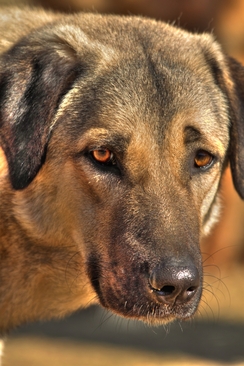|
November 25, 2012
Anatolian Shepherd as LGDs
Anatolian Shepherds as Livestock Guard Dogs
By: Theresa Pitts

Simba - Anatolian Shepherd
When we first established our farm, we knew we had predators to contend with. In our area, we have coyotes, foxes and domesticated dogs. While other areas may have more and some think they have none, I want to make sure everyone understands that DOMESTICATED DOGS pose the second biggest threat to your livestock. That's right, your friendly neighborhood stray dog or recently escaped household pet. Dogs will hunt in packs, for fun. They can and will kill livestock, even if they are not hungry. It is a sport for them. Your first biggest threat walks on two legs. Humans. There is no end to the depravity of humans when it comes to mistreating animals. With the choice that we made for protecting our livestock, we feel very confident that any 2 legged predator with nefarious purposes may make it into the field (only if they aren't very bright), but they won't make it out. Let's review the options that we considered to guard our new herd:
- Llamas - While they make excellent sentries and are some very protective (just try to give a cria a shot in our field and you will have Reba, one of our Mama Llamas standing over you to make sure you don't harm that baby in any way), we don't believe that they could fend off more than a single attacker at a time. We have 8 Llamas with our Alpacas and they do a great job at being extra eyes and ears for our LGDs.
- Donkeys - They assimilate with the herd and are quite effective at killing a dog or coyote. Not sure that they would stand up to a human or a bear. Although they wouldn't do it on purpose, the kick from a Donkey could kill a cria and we weren't prepared to accept that risk.
- Great Pyrenees - I have heard excellent things about this breed of LGDs and the breed has been performing this work for a very long time. Our major concerns were perception that this breed likes to wander, if given the chance and the dense, long coat of fur they carry. Now, I don't know if it is a fact that they like to wander, but it is what I've been told. We are in middle Georgia and our summers can be brutal. We don't feel that a dog with this much fur would do well in our climate.
- Maremmas - This is also an excellent choice for a LGD. But, like the Great Pyrenees, they also have a dense coat. This eliminated this breed for our farm.
- Anatolian Shepherds - For us, this was the perfect choice. The breed has been guarding livestock for hundreds of years and they have a short coat of fur. In winter, they will grow a second undercoat to withstand even the coldest weather. In Summer, they will shed this undercoat to deal with the heat. We have found this breed to be protective and loyal to our alpacas. We have found that they work best in teams of 2.
This list is not meant to include every option that you have for guardians for your herd, it is just the ones that we considered. This list reflects our opinions and the information that we used to make a decision for our farm. Also, I would like to touch on the subject of utilizing rescues as guardians for your herd. It is a sad subject, but unfortunately, there are LGDs that have been obtained by rescue organizations. Whether it is due to neglect, abuse or unfortunate circumstances. The rescue organizations provide an invaluable service and need our support. But, remember, if you obtain your LGD from one of these organizations, you do not know what that animal may have been subjected to. This is an animal that you will trust with your livestock. When using a rescue to guard your herd, please just keep in mind that you may need to keep a vigilant eye for any aberrant behavior. For anyone who is contemplating getting dogs to guard their livestock, please understand that puppies will be puppies. No matter what breed you choose, you will have to deal with "puppy" issues. Playing, chewing, digging and other mischievous behaviors. You CANNOT correct your LGD by striking or harming them. You must understand the proper methods to correct unwanted behavior and also understand what behaviors are normal and cannot be stopped. For more information about this topic, please visit these links: http://www.lgd.orghttp://www.dogbreedinfo.com/anatolianshepherd.htmhttp://www.anatoliandog.orghttp://en.wikipedia.org/wiki/Anatolian_Shepherd_Dog |